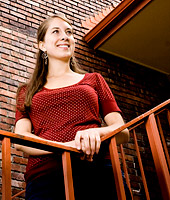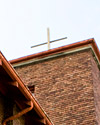The “Emerging” Movement
Reinventing Church to Reach Postmoderns
Return to Response
 By Bob Davies By Bob Davies
Anne-Marie Hunsaker joined Church of the Apostles (COTA) in Seattle’s Fremont neighborhood in the midst of a life crisis. It was December 2006 and Hunsaker, a Seattle Pacific University junior at the time, was deeply depressed. “It felt like something about my faith was wrong,” she recalls. “I was letting God down. I felt so guilty.”
At COTA, which has both Episcopal and Lutheran ties, one of the pastors reached out to her; they met for coffee almost weekly for the next seven months. Their conversations led to a life-changing discovery for Hunsaker: “I could be a Christian and be struggling with my faith at the same time. It was totally normal.”
Her pastor’s honest responses to hard questions, and the fellowship that COTA provided during Hunsaker’s hardship, provided what many young Christians are seeking: authenticity and community. These are two of the values at the heart of a growing trend among 21st-century Christians, a sometimes-controversial movement called “the emerging church.”
So, what is an “emerging church,” exactly? That definition is still, well … emerging. But there are some common values. In their book Emerging Churches, Eddie Gibbs and Ryan K. Bolger, describe these churches as follows: “Emerging churches (1) identify with the life of Jesus, (2) transform the secular realm, and (3) live highly communal lives. Because of these three activities, they (4) welcome the stranger, (5) serve with generosity, (6) participate as producers, (7) create as created beings, (8) lead as a body, and (9) take part in spiritual activities.”
COTA is one of dozens of churches highlighted in the book. “We are in the midst of a cultural revolution,” claim Gibbs and Bolger, and traditional churches “do not communicate clearly to twenty-first-century cultures.”
Seeing "authentic faith lived out"
 The authors, both professors at Fuller Theological Seminary, know their subject. Gibbs is the Donald A. McGavran Professor of Church Growth, and Bogler is an assistant professor of church in contemporary culture and director of the master of arts program in global leadership at the seminary’s School of Intercultural Studies. They assert that the Christian church “increasingly occupies a place on the margins of society,” and must radically re-invent itself to remain relevant. In a postmodern culture, they write, rational defenses of the faith are not the primary attraction of churches today for many young people. Many are instead drawn by the experiential — seeing authentic faith lived out in a local church context. The authors, both professors at Fuller Theological Seminary, know their subject. Gibbs is the Donald A. McGavran Professor of Church Growth, and Bogler is an assistant professor of church in contemporary culture and director of the master of arts program in global leadership at the seminary’s School of Intercultural Studies. They assert that the Christian church “increasingly occupies a place on the margins of society,” and must radically re-invent itself to remain relevant. In a postmodern culture, they write, rational defenses of the faith are not the primary attraction of churches today for many young people. Many are instead drawn by the experiential — seeing authentic faith lived out in a local church context.
Randy Rowland, pastor of another emerging church in Seattle’s Greenwood neighborhood — Sanctuary — notes that the term “emerging church” dates back to the late 1960s. “The current emerging church,” he says, “is an attempt to bring spiritual renewal to the church. While this renewal is spoken of as an attempt to be evangelistic and inclusive, which I believe is honestly being attempted, it is also and more notably a movement of churches utilizing the gifts, stories, and desires of a church-disaffected population, largely consisting of younger adults, who are giving the church ‘one last shot’ before giving up on the institution altogether.”
Emerging churches are diverse, making simple definitions hard to pin down. Some are church plants from established denominations such as Christian Reformed or Lutheran; others began as a youth service at a large church and grew into an independent congregation. Core doctrines typically reflect a particular church’s denominational roots or the founding pastor’s spiritual background.
“Sanctuary is a neighborhood church,” describes Rowland, “contextualized to a Northwest urban environment and a desire to practice relevance and presence within a boundaried geographic area. Our purpose is worship, hospitality, evangelism, and the renewal of creation insofar as is possible for one little group.”
COTA blends cutting-edge culture and ancient liturgy. Movie clips are interspersed with the Apostles’ Creed; labyrinths and icons are mixed with original rock songs and ancient hymns. The eclectic mix might be disorienting to some, but is deeply attractive to others — especially young people looking for connection with the historical church.
Kelly Head ’07 recalls his first visit: “It seemed like nothing I had experienced before” after growing up in a rural Missouri church. He liked the prevalence of the visual arts, and a reference to South Park in the sermon caught his ear. “They were on pace, not one step behind culture.”
The link to the historic church
 Head was also drawn to COTA’s link with the historic church. His interest in the early church was sparked by an ecclesiology course at SPU. “We really value the ancient church [at COTA],” he explains. “We’re very liturgical, so we draw a lot from the church calendar.” Head was also drawn to COTA’s link with the historic church. His interest in the early church was sparked by an ecclesiology course at SPU. “We really value the ancient church [at COTA],” he explains. “We’re very liturgical, so we draw a lot from the church calendar.”
Superficially, this “new” way of doing church may not seem unusual to newcomers. It may appear to be traditional — with incense, candles, icons, and creeds. But the participants insist that “emerging” congregations offer something that meets a particular need. For example, the typical emerging church is small enough that people know one another’s stories. This sense of community drew SPU senior Ben Carson to Sanctuary.
“I didn’t like the rock-star pastor mentality that I saw in other churches,” says Carson, who recalled seeing the pastor of one of Seattle’s largest churches in a local coffee shop. “I almost felt like I should ask him for an autograph.” Instead of a megawatt leader, Carson was looking for a church with in-depth relationships: “I want to be known by the body that I am part of.”
Senior Emily Davis wanted — and found — the same familiarity at Sanctuary. By her second visit, people were calling her by name. She’s been a regular ever since.
Growing up in south Orange County, Davis says that the church people she met were “very isolated.” Being at Sanctuary is the first time she’s experienced what she describes as authentic Christian community. She recalls the words of a friend who said after just one visit: “This is what church is supposed to look like.”
At the same time, this fellowship reaches beyond its own walls. Many members volunteer at the church-owned Green Bean café, a popular meeting spot for both church people and non-churched neighbors alike.
“The people of Greenwood see [Green Bean] as a place of community,” says Davis, who volunteers at the café several hours each week. “There’s a trust here.” She notes that spiritual conversations are a natural by-product of that trust, instead of an imposed agenda. “We just want to love on our neighbors.”
Depressed and questioning her faith, Anne-Marie Hunsaker found love — and a spiritual home — at COTA. She now serves on the church’s worship team, has preached twice, and plans to pursue ordination. “My experiences at Church of the Apostles have been extremely powerful for me,” she says.
Her story isn’t all that unusual, says Davis, who believes that many members of her generation are looking for a church experience that is “more than just rules or going through the motions. We want to be a church that gets back to Jesus, who he really is.”
|